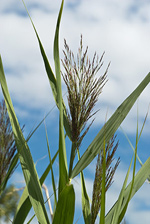|
||||||
|
PHRAGMITES. Common Reed. [Poaceae] |
|
|
Only one species of Phragmites, the Common Reed (P. australis), is recorded in Britain. It is a native species. Seventeen British miners are recorded on Phragmites. Nearly 100 British miners or possible miners are recorded on grasses in Britain. A key to the European miners recorded on Phragmites is provided in Bladmineerders van Europa. It is recommended that adults of all miners on grasses be reared to be certain of their identity. |
|
Key for the identification of the known mines of British |
Note: Diptera larvae may live in a corridor mine, a corridor-blotch mine, or a blotch mine, but never in a case, a rolled or folded leaf, a tentiform mine or sandwiched between two more or less circular leaf sections in later instars. Pupation never in a cocoon. All mining Diptera larvae are leg-less maggots without a head capsule (see examples). They never have thoracic or abdominal legs. They do not have chewing mouthparts, although they do have a characteristic cephalo-pharyngeal skeleton (see examples), usually visible internally through the body wall. The larvae lie on their sides within the mine and use their pick-like mouthparts to feed on plant tissue. In some corridor miners frass may lie in two rows on alternate sides of the mine. In order to vacate the mine the fully grown larva cuts an exit slit, which is usually semi-circular (see Liriomyza huidobrensis video). The pupa is formed within the hardened last larval skin or puparium and as a result sheaths enclosing head appendages, wings and legs are not visible externally (see examples). See Key to non-Diptera. |
1# > Leaf-miner: Details unknown. |
|
Thrypticus smaragdinus Gerstaecker, 1864 [Diptera: Dolichopodidae]. |
1a > Leaf-miner: Normally three or four eggs laid together. The larvae form a large communal mine, feeding first up and then down the leaf. Pupation external, the puparium frequently adhering to the leaf near the end of the mine (Spencer, 1972b: 38). Three or four eggs are deposited in a row, at right angle to the leaf margin. After hatching each of the larvae makes a corridor in the direction of the leaf tip. The corridors widen, and fuse into one upper-surface blotch. Frass in comparatively large lumps. Pupuation as a rule outside the mine. |
|
Agromyza hendeli Griffiths, 1963 [Diptera: Agromyzidae]. |
1b > Leaf-miner: Several eggs are normally laid together side by side at the tip of the leaf, the young larvae feeding first towards the apex of the leaf and then forming a large communal blotch running down the leaf. Pupation normally external, frequently adhering to the leaf (Spencer, 1976: 132). A number of eggs are deposited in a transverse row, not far from the leaf margin. The larvae that emerge start to make an individual corridor in the direction of the leaf tip. The corridors quickly widen and merge into one communal, upper-surface, mine. Frass powdery. Pupation as a rule outside the mine. |
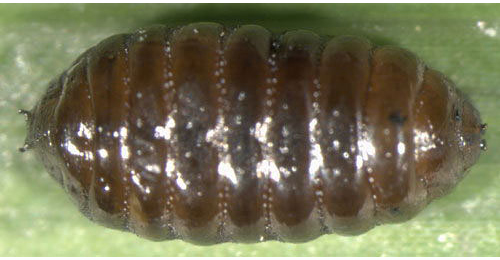 Agromyza phragmitidis puparium Image: © Willem Ellis (Bladmineerders van Europa) |
|
Agromyza phragmitidis Hendel, 1922 [Diptera: Agromyzidae]. |
1c > Leaf-miner: A linear mine with two rows of frass (Spencer, 1976: 112, fig. 181). Eggs are deposited singly, near the leaf margin, at some distance from the leaf tip. From this point an upper-surface corridor-blotch develops. Initially a narrow corridor ascends towards the tip; after some time the direction switches and the mine, now widening quickly, descends towards the leaf base. Frass in two rows. Puparium within the mine. |
|
Agromyza graminicola Hendel, 1931 [Diptera: Agromyzidae]. |
1d > Leaf-miner: A large linear-blotch mine in the leaf blade. Pupation normally in the mine. Puparium metallic black |
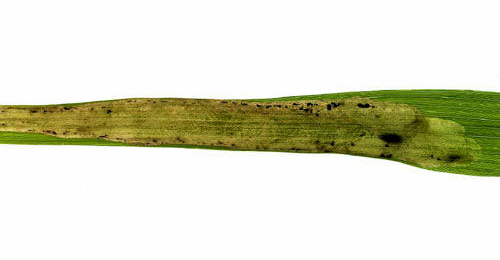 Mine of Cerodontha phragmitidis Image: © Willem Ellis (Bladmineerders van Europa) |
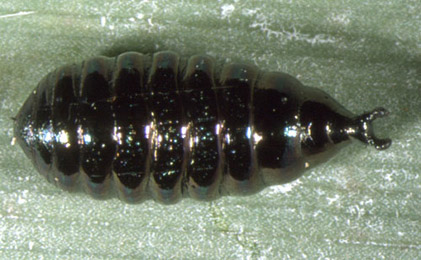 Cerodontha phragmitidis puparium Image: © Willem Ellis (Bladmineerders van Europa) |
|
Cerodontha phragmitidis Nowakowski, 1967 [Diptera: Agromyzidae]. |
1e > Leaf-miner: Vertically oriented corridor in the leaf sheath (very rarely in the blade). Often several mines together, sometimes confluent. Frass in dispersed little granules. Pupation within the mine. |
|
Cerodontha phragmitophila Hering, 1935 [Diptera: Agromyzidae]. |
1f > Leaf-miner: Lower-surface corridor in the top half the leaf blade; the mine changes direction at least two times. One to three larvae in a mine. Frass in rather regular granules. |
|
Cerodontha atra (Meigen, 1830) [Diptera: Agromyzidae]. |
1g > Leaf-miner: Broad elongated mine; the form is dependent of the leaf form of the host plant. Frass green. Usually a number of larvae together in a mine. Pupation in the mine. |
|
Cerodontha incisa (Meigen, 1830) [Diptera: Agromyzidae]. |
1h > Leaf-miner: Normally several larvae feed together. Pupation in the mine (Spencer, 1976: 198). Broad elongated blotch. Frass greenish. Larvae generally communal. Pupation within the mine. The black puaria are individially anchored within the mine with a silken thread attached at their rear end. Distinguishable from C. incisa only by means of the larva. |
|
Cerodontha pygmaea (Meigen, 1830) [Diptera: Agromyzidae]. |
1i > Leaf-miner: A short narrow mine, generally near apex of leaf. Larva with each segment bearing a row of characteristic papilli which are retained in the puparium (Spencer, 1976: 328). Pupation internal. Transparent, short and narrow mine not far from the leaf tip. Frass in two rows of grains. Pupation outside the mine. |
|
Pseudonapomyza atra (Meigen, 1830) [Diptera: Agromyzidae] |
1j > Leaf-miner: Irregular mine, locally shallow, elsewhere much deeper, giving it a mottled appearance. In broadleaved plants the mine often begins as a blotch with stellate extensions, but sometimes as a very fine, shallow corridor. In grasses the mine often begins in the leaf sheath. The frass is very fine-grained, initially scattered, later in aggregates. The egg is deposited on the plant surface, and the empty egg shell remains visible. But the larvae are able to leave their mine and restart elsewhere, thus mines without an egg shell can be found as well. The larva also leaves the mine before pupation. Pupation takes place in a newly made, small, blotch mine without frass; this mine may be made in another plant (species). |
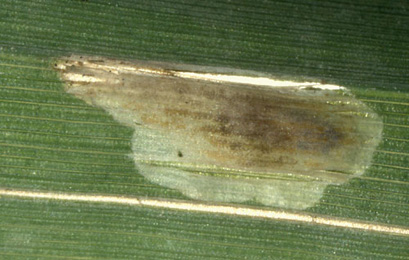 Mine of Hydrellia griseola on Glyceria fluitans Image: © Willem Ellis (Bladmineerders van Europa) |
|
Hydrellia griseola (Fallén, 1813) [Diptera: Ephydridae]. |
1k > Leaf-miner: Pale coloured corridor (here and there with even paler segments). Pupation within the mine. |
|
Thrypticus bellus Loew, 1869 [Diptera: Dolichopodidae] |
|
Key for the identification of the known mines of British |
Note: The larvae of mining Coleoptera, Hymenoptera and Lepidoptera may live in a corridor mine, a corridor-blotch mine, a blotch mine, a case, a rolled or folded leaf, a tentiform mine or sandwiched between two more or less circular leaf sections in later instars. Larva may pupate in a silk cocoon. The larva may have six legs (although they may be reduced or absent), a head capsule and chewing mouthparts with opposable mandibles (see video of a gracillarid larva feeding). Larvae of Hymenoptera and Lepidoptera usually also have abdominal legs (see examples). Frass, if present, never in two rows. Unless feeding externally from within a case the larva usually vacates the mine by chewing an exit hole. Pupa with visible head appendages, wings and legs which lie in sheaths (see examples). |
| 1a > Leaf-miner: Makes an elongate mine with frass heaped at the start and then dispersed thoughout. It does not make a silken shelter and so may be seen in the mine. At first a gallery, but soon widened to a broad blotch, entirely or partly running upwards, in the end half as wide as the leaf. The mine is widened without consideration for the length veins, making the mine less sharply delineated than in C. scribaiella. Most frass in the first section, but higher up still some scattered frass visible. Unlike C. scribaiella the larva does not spin a shelter for retreat in the mine; this makes the larva easily visible in the unopened mine. Cocoon in the top section of the mine. The pupa lies head-upwards, just below an opening that has been prepared as an exit for the later moth. |
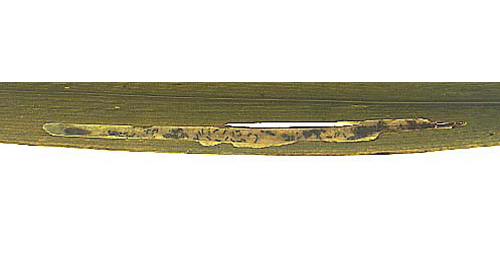 Mine of Cosmopterix lienigiella on Phragmites australis Image: © Willem Ellis (Bladmineerders van Europa) |
|
Cosmopterix lienigiella Zeller, 1846 [Lepidoptera: Cosmopterigidae]. |
1b > Leaf-miner: Makes long narrow galleries. The frass is distributed through the mine and also some is ejected. The larvae may mine more than one leaf. Elongate, rather irregular blotch. Most frass is ejected, what remains is concentrated in a few heaps. The larva makes several mines. Pupaton outside the mine. |
|
Cosmopterix orichalcea Stainton, 1861 [Lepidoptera: Cosmopterigidae]. |
1c > Leaf-miner: Initially a corridor, but in the end half as wide as the blade. Widening of the mine is done by adding all tissue between two thick longitudinal veins. Most frass in the lowest part of the mine; part of it is ejected through a number of small holes. Both during hibernation as in the pupal stage the larva occupies the lowest part of the mine; the larva has spun a tube here into which it also retracts during feeding pauses. The pupa is laying head downwards, just above a preformed exit opening. |
|
Cosmopterix scribaiella Zeller, 1850 [Lepidoptera: Cosmopterigidae]. |
1d > Leaf-miner: Common reed and similar plants are the larval foodplant. The larva of this species has a peculiar habit of cutting part of a leaf to act as a raft, using this to float on the water to a new foodplant when necessary. Narrow, whitish, rather inflated corridor, sometimes several tens of centimeters long, running towards the leaf sheath. Frass in coarse grains, in a distinct central line. Now and then the larva makes a elongate case from leaf material and uses it to float to another hostplant. The case may stick for some time to the new host. The larva pupates in a stem, after having made an exit hole and closed it with silk. |
|
Donacaula forficella (Thunberg, 1794) [ Lepidoptera: Crambidae]. |
1e > Leaf-miner: Larva makes a large whitish blotch and mines the leaf downwards. The frass tends to be deposited in the upper part of the mine. Oviposition usually not far from the leaf tip. From there descends an irregular blotch mine. Hering (1957a) describes the mine as flat and quite shallow, giving it a greenish, rather than whitish appearance. Frass initially in the oldest, upper part of the mine, later in strings. The larva can leave its mine and restart elsewhere. Normally only one larva per mine, but sometimes two or even three mines in a leaf. Pupation outside the mine. |
|
Elachista maculicerusella (Bruand, 1859) [Lepidoptera: Elachistidae]. |
| Last updated 06-Jul-2019 Brian Pitkin | ||

